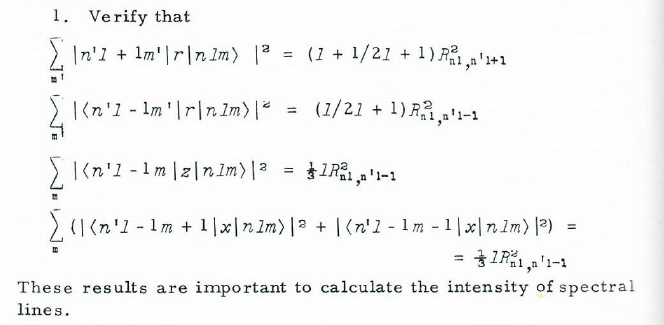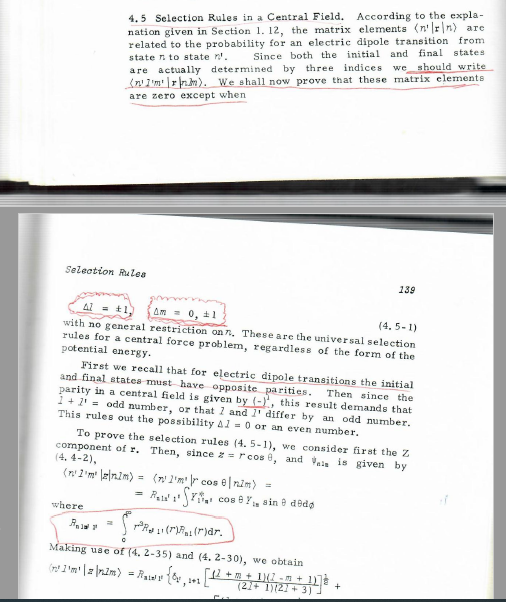Home /
Expert Answers /
Advanced Physics /
quantum-mechanics-1-verify-that-begin-array-l-left-sum-m-1-pa679
(Solved): quantum mechanics 1. Verify that \[ \begin{array}{l} \left.\sum_{m}^{1}\ ...
quantum mechanics

1. Verify that \[ \begin{array}{l} \left.\sum_{m}^{1}\left|n^{\prime} 1+1 m^{\prime}\right| r|n 1 m\rangle\right|^{3}=(1+1 / 21+1) R_{n_{1}, n^{\prime} 1+1}^{2} \\ \sum_{m}^{-1}\left|\left\langle n^{\prime} 1-1 m^{\prime}|r| n I m\right\rangle\right|^{2}=(1 / 21+1) R_{n_{1}, n^{\prime} 1-1}^{2} \\ \sum_{m}\left|\left\langle n^{\prime} 1-1 m|z| n I m\right\rangle\right|^{3}=\frac{1}{3} 1 R_{n 1, n^{\prime} 1-1}^{2} \quad \\ \sum_{m}^{-}\left(\left|\left\langle n^{\prime} 1-1 m+1|x| n 1 m\right\rangle\right|^{2}+\left|\left\langle n^{\prime} 1-1 m-1|x| n 1 m\right\rangle\right|^{2}\right)= \\ =\frac{2}{3} I R_{n 1}^{2} n^{\prime}{ }^{\prime} 1-1 \end{array} \] These results are important to calculate the intensity of spectral lines.
4.5 Selection Rules in a Central Field. According to the explanation given in Section 1. 12, the matrix elements \( \left\langle n^{\prime}|r| n\right\rangle \) are related to the probability for an electric dipole transition from state \( n \) to state \( n^{\prime} \). Since both the initial and final states are actually determined by three indices we should write \( \left\langle n^{\prime} l^{\prime} m^{\prime}|r| a m\right\rangle \). We shall now prove that these matrix elements are zero except when Seleation Puliea rules for a central force problem, rese are the universal selection potential energy. First we recall that for electric dipole transitions the initial and final states-must have opposite parities. Then since the parity in a central field is given by \( (-)^{1} \), this result demands that \( 1+l^{\prime}= \) odd number, or that 1 and \( l^{\prime} \) differ by an odd number. This rules out the possibility \( \Delta I=0 \) or an even number. To prove the selection rules \( (4.5-1) \), we consider first the \( \mathrm{Z} \) component of \( r \). Then, since \( z=r \cos \theta \), and \( \psi_{\text {as }} \) is given by \( (4,4-2) \), \[ \begin{array}{l} \left\langle n^{\prime} l^{\prime} m^{\prime}|z| n l^{\prime}\right\rangle=\left\langle n^{\prime} 1^{\prime} m^{\prime}|r \cos \theta| n \eta_{m}\right\rangle= \\ \text { where } \\ A_{\mathrm{n}] \|}=\int_{0}^{\infty} r^{9} R_{v 11}(r) F_{\mathrm{n} 1}(r) \mathrm{d} r_{.} \\ \text {Making use of }(4,2-35) \text { and }(4,2-30) \text {, we obtain } \\ \left\langle n^{\prime} I^{\prime} m^{\prime}|z| n, I m\right\rangle=R_{n|z|}\left\{\left\{\delta_{1 r}, 1+1\left[\frac{(2+m+1)(2-m+1)}{(2 I+1)(21+3)}\right]{ }^{\frac{1}{2}}+\right.\right. \\ \end{array} \]
\[ \left.+\delta_{11}, 1-1\left[\frac{(l+m)(1-m)}{(2 I+1)(2 l+3)}\right]^{\frac{1}{2}}\right\}_{k=1} . \quad(4,5-2) \] It is evident that Eq. \( (4,5-2) \) requires that \( l^{\prime}=I \pm 1 \), or \( \Delta l=\pm l \) and \( m=m^{1} \) or \( \Delta m=0 \). The calculation of the matrix elements for coordinates \( x \) and y follows by noting that \[ \begin{array}{l} (4,2-30) \text { to obtain } \\ \left\langle n^{\prime} I^{\prime} m^{\prime}|x \pm t y| n \geq{ }^{\prime}\right\rangle=R_{11 \mathrm{a}_{1}{ }^{1}}\left\{\left\{\delta_{L^{\prime}, 1+1}\left[\frac{(2+m+1)(1+m+2)}{\left.(2)+1)(2)^{2}+3\right)}\right] \text { ?? } \pm\right.\right. \\ \left.+8_{1},:-1\left[\frac{(1-m)(2-m-1)}{(21+1)(21-1)}\right]^{\left.\frac{1}{2}\right)}\right]_{n},{ }^{\prime},=\pm 1,(4,5-3) \\ \text { which requires that again } l^{\prime \prime}=1 \pm 1 \text { or } \Delta l=\pm 1 \text { and that } m^{\prime}=m \neq 1 \\ \text { or } \Delta m=\pm 1 \text {. } \\ \end{array} \] \[ 140 \] Central Forces Since \( \Delta m=0 \) is associated with the z-mat rix only, a transition of this kind can be considered as due to an oscillation parallel to the \( Z \) axis, thus giving rise to radiation polarized along the \( Z \) axis. On the other hand, a transition with \( \Delta m=\pm 1 \) is associated with both \( x \) and \( y \) corresponding to an oscillator in the \( X Y \)-plane. The latter gives rise to radiation polarized perpendicular to the \( Z \) axis or elliptically polarized in the \( X Y \)-plane. As well shall see in Chapter IX, the selection rules(4.5-1) follow from the conservation of angular momentum as applied to the radiating system plus emitted or absorbed radiation.
Expert Answer
The selection rules (4.5-1) are a set of conditions that must be met for electric dipole transitions to occur in a central field. These rules state th

![\[
\left.+\delta_{11}, 1-1\left[\frac{(l+m)(1-m)}{(2 I+1)(2 l+3)}\right]^{\frac{1}{2}}\right\}_{k=1} . \quad(4,5-2)
\]
It is](https://media.cheggcdn.com/media/70f/70f9efc8-4120-42fe-81db-6d3132d8b6cf/php8MRdzr)